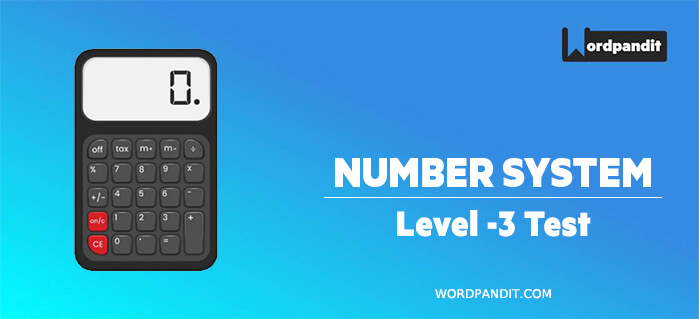- This is an assessment test.
- To draw maximum benefit, study the concepts for the topic concerned.
- Kindly take the tests in this series with a pre-defined schedule.
Number System: Level 3 Test -5
Congratulations - you have completed Number System: Level 3 Test -5.You scored %%SCORE%% out of %%TOTAL%%.You correct answer percentage: %%PERCENTAGE%% .Your performance has been rated as %%RATING%%
Your answers are highlighted below.
Question 1 |
How many five-digit numbers can be formed by using the digits 2, 3, 8, 7, 5 such that each digit is used only once, and also the number is divisible by 125?
0 | |
1 | |
4 | |
3 |
Question 1 Explanation:
Let us find some of the smaller multiples of 125.
They are 125, 250, 375, 500, 625, 750, 875, 1000 ...
A five-digit number is divisible by 125, if the last three digits are divisible by 125.
So the possibilities are 375 and 875, 5 should come in unit’s place, and 7 should come in ten’s place.
Thousand’s place should contain 3 or 8. We can do it in 2! ways.
Remaining first two digits, we can arrange in 2! ways.
So we can have 2! × 2! = 4 such numbers.
There are: 23875, 32875, 28375, 82375.
They are 125, 250, 375, 500, 625, 750, 875, 1000 ...
A five-digit number is divisible by 125, if the last three digits are divisible by 125.
So the possibilities are 375 and 875, 5 should come in unit’s place, and 7 should come in ten’s place.
Thousand’s place should contain 3 or 8. We can do it in 2! ways.
Remaining first two digits, we can arrange in 2! ways.
So we can have 2! × 2! = 4 such numbers.
There are: 23875, 32875, 28375, 82375.
Question 2 |
x and y are real numbers satisfying the following conditions 2 < x < 3 and – 8 < y < –7. Which of the following expressions have the least value?
x2y | |
xy2 | |
5xy | |
None of these |
Question 2 Explanation:
The value of y would be negative and the value of x would be positive from the inequalities given in the question. Therefore, from (a), y becomes positive.
The value of xy2 would be positive and will not be the minimum.
From (b) and (c), x2y and 5xy would give negative values but we do not know which would be the minimum. On comparing (a) and (c),
we find that x2 < 5x in 2 < x < 3. ∴x2y > 5xy [Since y is negative.] 5xy would give the minimum value
The value of xy2 would be positive and will not be the minimum.
From (b) and (c), x2y and 5xy would give negative values but we do not know which would be the minimum. On comparing (a) and (c),
we find that x2 < 5x in 2 < x < 3. ∴x2y > 5xy [Since y is negative.] 5xy would give the minimum value
Question 3 |
How many numbers can be formed by using digits 1, 2, 3, 4, 5, without repetition, also the digit at the unit’s place must be greater than that in the ten’s place?
54 | |
60 | |
17 | |
2 × 4! |
Question 3 Explanation:
The digit in the unit’s place must be greater than that in the ten’s place.
So if we have 5 in the unit’s place, the remaining 4 digits need not be in any particular order.
So we will have 4! numbers.
However, if we have 4 in the unit’s place, we cannot have 5 in the ten’s place.
Hence, the ten’s place has to be one among 1, 2 or 3.
This can be done in 3 ways. The remaining 3 digits can be filled in the remaining three places in 3! ways.
Hence, total we will have (3 × 3!) numbers ending in 4. Similarly,
if we have 3 in the unit’s place, the ten’s place can only be 1 or 2.
This can be done in 2 ways. The remaining 3 digits can be arranged in the remaining 3 places in 3! ways.
Hence, we will have (2 × 3!) numbers ending in 3. Similarly, we can find that there will be (3!) numbers ending in 2 and no number ending in 1.
So total number of numbers satisfying the given condition = 4! + (3 × 3!) + (2 × 3!) + 3! = 4! + 6 × 3! = 24 + (6 × 6) = 60.
So if we have 5 in the unit’s place, the remaining 4 digits need not be in any particular order.
So we will have 4! numbers.
However, if we have 4 in the unit’s place, we cannot have 5 in the ten’s place.
Hence, the ten’s place has to be one among 1, 2 or 3.
This can be done in 3 ways. The remaining 3 digits can be filled in the remaining three places in 3! ways.
Hence, total we will have (3 × 3!) numbers ending in 4. Similarly,
if we have 3 in the unit’s place, the ten’s place can only be 1 or 2.
This can be done in 2 ways. The remaining 3 digits can be arranged in the remaining 3 places in 3! ways.
Hence, we will have (2 × 3!) numbers ending in 3. Similarly, we can find that there will be (3!) numbers ending in 2 and no number ending in 1.
So total number of numbers satisfying the given condition = 4! + (3 × 3!) + (2 × 3!) + 3! = 4! + 6 × 3! = 24 + (6 × 6) = 60.
Question 4 |
Three wheels can complete 60, 36 and 24 revolutions per minute. There is a red spot on each wheel that touches the ground at time zero. After how much time, all these spots will simultaneously touch the ground again?
5/2s | |
5/3s | |
6 s | |
7.5 s |
Question 4 Explanation:
The time taken by the white spots on all three wheels to simultaneously touch the ground again will be equal to the LCM of the times taken by the three wheels to complete one revolution.
The first wheel complete 60 revolutions per minute. This means that to complete one revolution, it takes1 sec.
The second wheel completes 36 revolutions per minute.
So to complete one revolution, it takes 36/60=3/5sec. Similarly, the third wheel takes24/60=2/5s to complete one revolution.
Hence, LCM of 1,,3/5,2/5=lcm of 1,3,2/lcm of1,5,5 = 6 s
The first wheel complete 60 revolutions per minute. This means that to complete one revolution, it takes1 sec.
The second wheel completes 36 revolutions per minute.
So to complete one revolution, it takes 36/60=3/5sec. Similarly, the third wheel takes24/60=2/5s to complete one revolution.
Hence, LCM of 1,,3/5,2/5=lcm of 1,3,2/lcm of1,5,5 = 6 s
Question 5 |
A is the set of positive integers such that when divided by 2, 3, 4, 5, 6 it leaves the remainders 1, 2, 3, 4, 5 respectively. How many integers between 0 and 100 satisfy the condition and part of set A?
0 | |
1 | |
2 | |
None of these |
Question 5 Explanation:
Note that the difference between the divisors and the remainders is constant.
2 – 1 = 3 – 2 = 4 – 3 = 5 – 4 = 6 – 5 = 1
In such a case, the required number will always be [a multiple of LCM of (2, 3, 4, 5, 6) – (The constant difference)]. LCM of (2, 3, 4, 5, 6) = 60
Hence, the required number will be 60n – 1.
Thus, we can see that the smallest such number is (60 × 1) – 1 = 59
The second smallest is (60 × 2) – 1 = 119 So between 1 and 100, there is only one such number, viz. 59
2 – 1 = 3 – 2 = 4 – 3 = 5 – 4 = 6 – 5 = 1
In such a case, the required number will always be [a multiple of LCM of (2, 3, 4, 5, 6) – (The constant difference)]. LCM of (2, 3, 4, 5, 6) = 60
Hence, the required number will be 60n – 1.
Thus, we can see that the smallest such number is (60 × 1) – 1 = 59
The second smallest is (60 × 2) – 1 = 119 So between 1 and 100, there is only one such number, viz. 59
Once you are finished, click the button below. Any items you have not completed will be marked incorrect.
There are 5 questions to complete.
List |






